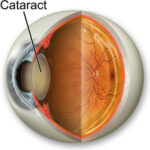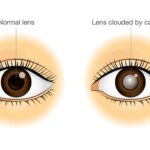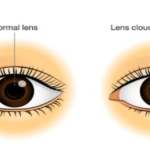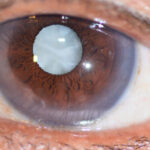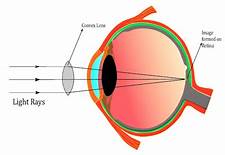Cataracts are often associated with aging, but did you know that they can also affect newborns? Congenital cataracts are a rare yet significant cause of visual impairment in children. Unlike age-related cataracts, which develop over time, congenital cataracts are present at birth or form shortly thereafter.
What is a Congenital Cataract?
A congenital cataract is a clouding of the eye’s lens that is present at birth or develops during infancy. The lens is a transparent structure in the eye that focuses light onto the retina, enabling clear vision. When a cataract forms, it prevents light from passing through the lens effectively, leading to blurred or impaired vision. Cataracts in children can vary in size and severity. They may affect one eye (unilateral) or both eyes (bilateral), and the degree of visual impairment depends on the size, density, and location of the cataract within the lens. In some cases, congenital cataracts are so small that they do not significantly impact vision and may not require immediate treatment.
Causes of Congenital Cataracts
The causes of congenital cataracts are diverse, and in many cases, multiple factors may contribute to their development. Some of the most common causes include:
1.Genetic Factors
Inherited Conditions: Congenital cataracts can be inherited from one or both parents. These cataracts may be part of a broader genetic syndrome or occur in isolation. For example, conditions like Down syndrome, Marfan syndrome, and congenital rubella syndrome are associated with an increased risk of congenital cataracts.
Gene Mutations: Specific gene mutations can lead to the development of congenital cataracts. These mutations may affect the proteins that make up the lens or its development during pregnancy.
2. Intrauterine Infections
TORCH Infections: Certain infections contracted by the mother during pregnancy can lead to congenital cataracts in the baby. These include Toxoplasmosis, Other agents (such as syphilis), Rubella, Cytomegalovirus (CMV), and Herpes simplex virus (TORCH). Rubella, in particular, is a well-known cause of congenital cataracts.
3. Metabolic Disorders
Galactosemia: This rare metabolic disorder affects how the body processes galactose, a sugar found in milk. Untreated galactosemia can lead to the formation of cataracts in infants, often within the first few weeks of life.
Diabetes: Maternal diabetes has been linked to an increased risk of congenital cataracts. High blood sugar levels during pregnancy can impact the developing lens, leading to clouding
4.Trauma
While less common, trauma to the eye during or after birth can cause cataracts to develop. In some cases, a traumatic injury to the eye can lead to the formation of a cataract shortly after birth.
Symptoms of Congenital Cataracts
The symptoms of congenital cataracts can vary depending on the severity and location of the cataract. Parents and caregivers should be vigilant for the following signs:
1.Leukocoria (White Pupil)
One of the most noticeable signs of a congenital cataract is a white or grayish-white reflection in the pupil, known as leukocoria. This is often the first sign that prompts parents to seek medical attention.
2.Nystagmus
Nystagmus is a condition characterized by involuntary, rapid eye movements. It can be a sign of visual impairment caused by congenital cataracts.
3.Poor Visual Tracking
Infants with congenital cataracts may have difficulty following objects with their eyes. They may not respond to visual stimuli as expected for their age.
4.Strabismus (Crossed Eyes)
Strabismus, or misalignment of the eyes, can occur in children with congenital cataracts, particularly if one eye is more affected than the other.
5.Delayed Visual Development
Infants with congenital cataracts may experience delayed visual development, leading to difficulties with eye-hand coordination and other developmental milestones.
Diagnosis of Congenital Cataracts
Early diagnosis of congenital cataracts is crucial for preventing long-term visual impairment. Paediatricians typically perform a red reflex test during routine newborn exams to check for any abnormalities in the eyes. If a cataract is suspected, the child will be referred to a paediatric ophthalmologist for further evaluation. The ophthalmologist will conduct a thorough eye examination, which may include:
Ophthalmoscopy
Slit-Lamp Examination
Ultrasound Imaging
Treatment Options for Congenital Cataracts
The treatment of congenital cataracts depends on several factors, including the size, location, and impact on vision. Early intervention is key to preventing long-term visual impairment. Treatment options include:
1.Observation
In cases where the cataract is small and does not significantly affect vision, the ophthalmologist may recommend regular monitoring to ensure that the cataract does not worsen.
2.Surgery
For larger cataracts that impair vision, surgery is often necessary. Cataract surgery in infants involves removing the clouded lens and replacing it with an artificial intraocular lens (IOL) or leaving the eye without a lens (aphakia) to be corrected with contact lenses or glasses later. Timing of surgery is critical, as delaying treatment can lead to irreversible vision loss.
3.Post-Surgical Care
After surgery, children may require visual rehabilitation, including the use of contact lenses or glasses to correct aphakia. In some cases, patching therapy may be needed to treat amblyopia (lazy eye) if one eye was more affected than the other.
Conclusion
Congenital cataracts are a serious but treatable condition that can significantly impact a child’s vision and development. Early detection and prompt intervention are crucial for preventing permanent visual impairment. Advances in surgical techniques and post- operative care have greatly improved outcomes for children with congenital cataracts, enabling them to lead healthy, visually-active lives. If you suspect your child may have a cataract, seek immediate evaluation from a paediatric ophthalmologist to ensure the best possible outcome.


